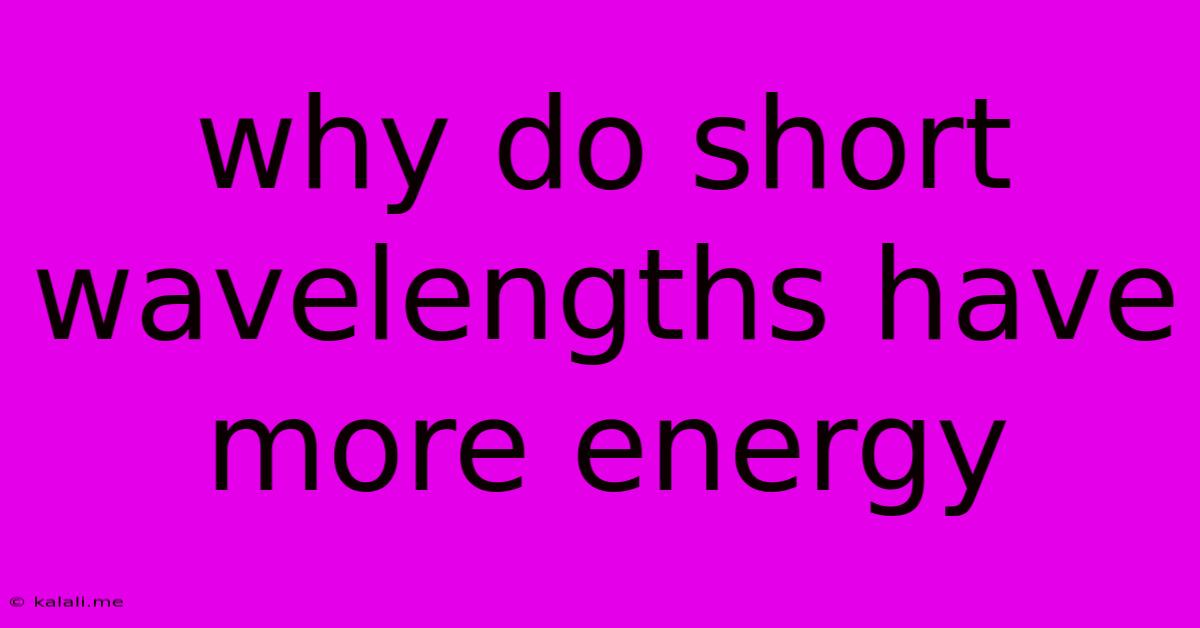Why Do Short Wavelengths Have More Energy
Kalali
Jun 05, 2025 · 3 min read

Table of Contents
Why Do Short Wavelengths Have More Energy? Understanding the Relationship Between Wavelength and Energy
The relationship between wavelength and energy is fundamental to understanding many aspects of physics, from the behavior of light and electromagnetic radiation to the properties of matter at the atomic level. This article will explore why shorter wavelengths possess higher energy, explaining the underlying principles in a clear and concise manner. We'll delve into the mathematical relationship and provide relatable examples to solidify your understanding.
The Inverse Relationship: A Fundamental Principle
The core concept lies in the inverse relationship between wavelength and frequency, which directly impacts energy. Wavelength (λ) is the distance between two consecutive crests (or troughs) of a wave, while frequency (ν) represents the number of wave cycles passing a fixed point per unit of time (usually measured in Hertz, Hz). The speed of light (c) in a vacuum is constant, and the relationship is defined by the equation:
c = λν
This equation shows that as wavelength decreases, frequency must increase to maintain a constant speed of light. Now, let's consider the energy (E) of a wave, which is directly proportional to its frequency:
E = hν
where 'h' is Planck's constant, a fundamental physical constant.
Combining these two equations, we can see the direct link between wavelength and energy:
E = hc/λ
This equation clearly demonstrates the inverse relationship: as wavelength (λ) decreases, energy (E) increases. Shorter wavelengths mean higher frequency, and higher frequency directly translates to higher energy.
Visualizing the Concept
Imagine two waves in the ocean: a long, rolling wave and a short, choppy wave. The long wave has a low frequency – it takes longer for a crest to pass a specific point. The short wave has a high frequency – crests pass the same point much more quickly. Similarly, the short, choppy wave is more powerful and carries more energy than the long, rolling wave. This analogy applies equally to electromagnetic radiation, including light, X-rays, and gamma rays.
Examples in the Electromagnetic Spectrum
The electromagnetic spectrum provides excellent examples of this principle. Radio waves, with their extremely long wavelengths, have very low energy. As we move towards shorter wavelengths, we encounter microwaves, infrared radiation, visible light, ultraviolet radiation, X-rays, and finally, gamma rays. Each step towards shorter wavelengths represents a significant increase in energy. Gamma rays, with the shortest wavelengths, are the most energetic form of electromagnetic radiation.
- Radio Waves: Longest wavelength, lowest energy
- Microwaves: Longer wavelength than visible light, lower energy than visible light
- Visible Light: Relatively short wavelengths, moderate energy levels. Violet light has a shorter wavelength (and therefore higher energy) than red light.
- X-rays: Short wavelengths, high energy, capable of penetrating soft tissue.
- Gamma Rays: Shortest wavelengths, highest energy, extremely penetrating.
Practical Implications
The relationship between wavelength and energy has significant practical implications across various scientific fields:
- Medical Imaging: X-rays and gamma rays, due to their high energy, are used in medical imaging because they can penetrate the body and reveal internal structures.
- Photovoltaic Cells (Solar Panels): Solar cells are designed to absorb photons of light at specific wavelengths. The energy from these photons is then converted into electricity.
- Spectroscopy: Analyzing the wavelengths of light emitted or absorbed by substances allows scientists to identify the chemical composition of those substances.
Understanding the inverse relationship between wavelength and energy is crucial for comprehending the behavior of light and other forms of electromagnetic radiation, as well as numerous applications in science and technology. This fundamental principle governs how we interact with the world at both the macroscopic and microscopic levels.
Latest Posts
Latest Posts
-
Fill A Hole In Concrete Floor
Jun 06, 2025
-
Why Is My Audi Delayed With A New Cord
Jun 06, 2025
-
Why Apache Display Full Server Path
Jun 06, 2025
-
Do You Need An Id For A Greyhound Bus
Jun 06, 2025
-
What Is The Purpose Of A Neutral Wire
Jun 06, 2025
Related Post
Thank you for visiting our website which covers about Why Do Short Wavelengths Have More Energy . We hope the information provided has been useful to you. Feel free to contact us if you have any questions or need further assistance. See you next time and don't miss to bookmark.